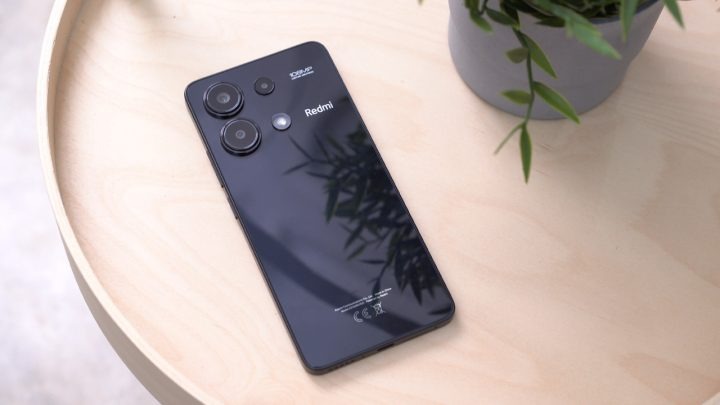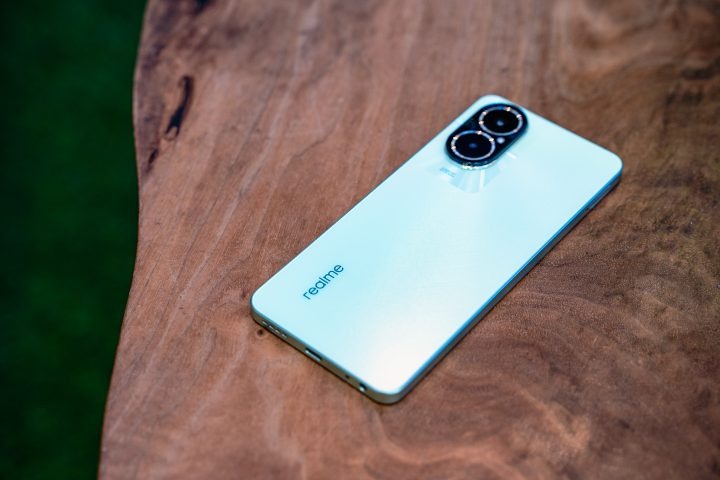The entry-level segment just got more heated this year as the Redmi Note 13 4G 23 and realme C67 34 launched both packing impressive feature set priced at just under PHP 10K. Today, we’ll be comparing these two to see which one serves more value on paper.

Although, spoiler: you’ll be surprised that both of these two sport 108-megapixel shooters. But one seems to stand out more despite it being more affordable than the other. And which model is that? We’re about to find out. Let’s begin!
Table of Contents
Beyond the spec sheet, it’s worth mentioning that these two new phones boast striking designs. The Redmi Note 13 has a simple, glossy back shell finish that’s surely made out of plastic.
What’s interesting is the design change they made with the layout: the camera rings look more symmetrical — complemented by the Redmi moniker on the right. They also removed the camera island bump and made the lenses directly on top of the rear panel.

However, this back panel finish is a smudge-magnet, so slapping a case on it is a no-brainer. Fortunately, the protective case in the box comes in a black, unibody silicone, not just the usual transparent jelly case.
On the other hand, I dig the realme C67’s design more with its vibrant, gradient satin finish. With this type of back panel, expect that it doesn’t leave fingerprints and smudge that much. Also, looking closer at it, one sees individual diagonal stripes that add a nice touch.

I also liked its camera island’s design even more. It has golden accented camera rings on top of a gradient, glossy area. In terms of design, the realme C67 looks more fun and alive as compared to Redmi Note 13’s more muted look.
As always, design is subjective so both phones get a point in this category.
Flip at the front, the realme C67 sports a larger 6.72-inch Full HD+ IPS LCD panel with 90Hz refresh and 950 nits of peak brightness.

This is where the Redmi Note 13 has a significant advantage against the competition with a 6.67-inch Full HD+ AMOLED display despite its smaller size. Adding to that is a much smoother visuals with support for up to 120Hz and an even brighter panel with 1800 nits peak brightness — matching the display specs on its Pro counterparts.
It has a TÜV Rheinland certification too for low blue light and flicker free certifications. Though they both have the same resolution, the Redmi Note 13 has a significantly thinner bezel at the chin.

Also expect the Redmi Note 13’s display to be scratch resistant thanks to a Corning Gorilla Glass 3 sandwiched on top.
Both have dual stereo speakers and Widevine L1 making them good for consuming high-resolution media. But what makes the Redmi Note 13 even better is its support for Dolby Atmos bringing richer stereo sound.
Fortunately, both models have the good ol’ 3.5mm audio jack for a more tailored audio experience. Otherwise, you can easily pair up your favorite wireless earbuds or headphones.
Clearly, the Redmi Note 13 dominates in this area.
Powering both devices is the Snapdragon 685 — a 6-nanometer class midrange, relatively old chipset from Qualcomm with up to 2.8GHz clock speed. Naturally, at first, I thought that they would have the same performance. But as I looked into the details, there are quite performance gaps between the two.
Looking at their synthetic benchmark scores, the Redmi Note 13 has garnered significantly higher scores across the board. On AnTuTu V10 benchmark, it hit 339,395 while the realme C67 was a shy 312,826. This ain’t that much of a difference, not until the AnTuTu storage test. The former had a higher score and even faster read and write speeds than the latter.
See the benchmark scores below for reference:
| Benchmarks | Redmi Note 13 | realme C67 |
| AnTuTu V10 | 339,395 | 312,826 |
| Antutu Storage Test | 29,029 | 13,185 |
| S. Read Speed | 896 MB/s | 297.7 MB/s |
| S. Write Speed | 586 MB/s | 273.0 MB/s |
| Geekbench 6 CPU (Single-core) | 424 | 474 |
| Geekbench 6 CPU (Multi-core) | 1,442 | 1,513 |
| PC Work 3.0 performance | 8,796 | 6,161 |
While the Redmi Note 13 has the numbers, this doesn’t represent the real-world use. So, both still get a point in terms of performance.
When it comes to cameras, despite both having 108-megapixel primary sensors, the realme C67 seems to stand out more. For some reason, it handles dynamic range better than the Redmi Note 13.

Even under low-light scenarios, the realme C67 can bring out a bit more detail and contrast. Perhaps this is because of the 108MP camera being a Samsung HM6 with an in-sensor zoom capability.

Its only letdown is only having a dual camera setup, and the secondary lens isn’t as capable too with only a 2MP depth sensor. Whereas the Redmi Note 13 has two more cameras: an 8-megapixel ultrawide and 2-megapixel macro.
Nonetheless, the point still goes to the realme C67 with its more capable primary camera. See the Redmi Note 13 sample shots here 730 and the realme C67 here 407.
Both pack the usual 5000 mAh battery capacity and with support for 33W wired charging. In our experience, both devices lasted for more than a day of normal usage: browsing the web and social media, watching videos on YouTube, and gaming on the side. Both get a point in this category.
With the Snapdragon 685, capped to 4G connectivity is expected. Taking out their SIM tray, only the realme C67 has a dedicated slot for microSD and with support for a larger expansion too at 2-terabytes. The Redmi Note 13 is left with a hybrid SIM tray and supports only 1-terabyte of expandable storage.
Software-wise, the realme C67 is running Android 14 (skinned with realme UI) out of the box. While the Redmi Note 13, as of now, runs on Android 13 (with MIUI 14 overlay).
This isn’t that big of a deal since it will soon get the HyperOS update (based on Android 14) in the first half of 2024. Also, both are IP54 rated for protection against some water splashes and dust.
The Redmi Note 13, apparently packs a few more features than the realme C67. First is the NFC capability, an IR blaster that makes it a convenient universal remote, and an in-screen fingerprint sensor — which is quite surprising at this price point.
Now to the most crucial part in this matchup, the price. The Redmi Note 13 4G dominates the competition thanks to its more immersive, brighter AMOLED display, better performance, and having more feature set to offer. The best part? It’s even more affordable, starting at only PHP 7,999USD 136INR 11,555EUR 130CNY 993 for the 6GB+128GB trim and PHP 9,999USD 170INR 14,445EUR 162CNY 1,241 for the 8GB+256GB config.

Compare that to the realme C67 whose price starts at PHP 9,999USD 170INR 14,445EUR 162CNY 1,241 for the 8GB+128GB variant — a two-thousand peso price difference. The jump to 8GB RAM might justify its price.
Another way of looking at this is by using the PHP 9,999USD 170INR 14,445EUR 162CNY 1,241 price point. You get the 8GB+128GB combo of the realme C67 against the similarly priced 8GB+256GB of the Redmi Note 13 4G. Now, we’ve painted a clearer picture.
Value-wise, the Redmi Note 13 ultimately brings more to the table at a more accessible price point.

I just wish that it had been more capable in terms of camera performance — which might be the realme C67’s biggest trump card on top of its great, vibrant design.
| Xiaomi Redmi Note 13 4G | realme C67 4G |
|---|---|
| 6.67-inch FHD+ AMOLED display | 6.72-inch FHD+ IPS LCD |
| 2400 x 1080 pixels, 120Hz refresh, 1800 nits (peak) | 1080*2400 pixels, 90Hz refresh, 950 nits (peak) |
| Corning Gorilla Glass 3 | |
| Qualcomm Snapdragon 685 | Qualcomm Snapdragon 685 |
| 6nm, 8-cores, up to 2.8GHz | 6nm, 8-cores, up to 2.8GHz |
| 6GB, 8GB LPDDR4x RAM (+8GB memory extension) | 8GB LPDDR4x RAM (+8GB extended memory) |
| 128GB, 256GB UFS 2.2 storage | 128GB, 256GB storage |
| Expandable up to 1TB via microSD (hybrid slot) | Expandable up to 2TB via microSD (dedicated slot) |
| Triple rear cameras: | Dual rear cameras: |
| - 108MP f/1.75 main | - 108MP f/1.75 Samsung ISOCELL HM6 camera (3x in-sensor zoom) |
| - 8MP f/2.2 ultrawide | - 2MP f/2.4 depth |
| - 2MP f/2.4 macro | |
| 16MP f/2.4 selfie shooter (hole punch notch) | 8MP selfie shooter (hole punch notch) |
| Dual nano-SIM | Dual nano-SIM |
| 4G LTE | 4G LTE |
| Wi-Fi 5 | Wi-Fi 2.4GHz/ 5GHz |
| Bluetooth 5.1 | Bluetooth 5.0 |
| GPS, GLONASS, BDS, GALILEO | GPS, GLONASS, GALILEO, Beidou, QZSS |
| USB Type-C | USB Type-C |
| 3.5mm audio jack | 3.5mm audio jack |
| NFC | |
| In-screen fingerprint sensor, face unlock | Side-mounted fingerprint sensor, face unlock |
| IP54 splash and dust resistance | IP54 splash and dust resistance |
| Dual stereo speakers, Dolby Atmos, IR blaster | Dual stereo speakers |
| MIUI 14 (Android 13) | realme UI (Android 14) |
| 5000mAh battery | 5000mAh battery |
| 33W wired charging (Mi Turbo charging) | 33W wired charging (SuperVOOC) |
| 162.24 x 75.55 x 7.97mm | 164.6 x 75.4 x ~7.59mm |
| 188.5g | ~185g |
| Midnight Black, Mint Green, Ice Blue, Ocean Sunset | Sunny Oasis, Black Rock |
| PHP 7,999 (6GB+128GB) PHP 9,999 (8GB+256GB) | PHP 9,999 (8GB+128GB) PHP 10,999 (8GB+256GB) |

YugaTech.com is the largest and longest-running technology site in the Philippines. Originally established in October 2002, the site was transformed into a full-fledged technology platform in 2005.
How to transfer, withdraw money from PayPal to GCash
Prices of Starlink satellite in the Philippines
Install Google GBox to Huawei smartphones
Pag-IBIG MP2 online application
How to check PhilHealth contributions online
How to find your SIM card serial number
Globe, PLDT, Converge, Sky: Unli fiber internet plans compared
10 biggest games in the Google Play Store
LTO periodic medical exam for 10-year licenses
Netflix codes to unlock hidden TV shows, movies
Apple, Asus, Cherry Mobile, Huawei, LG, Nokia, Oppo, Samsung, Sony, Vivo, Xiaomi, Lenovo, Infinix Mobile, Pocophone, Honor, iPhone, OnePlus, Tecno, Realme, HTC, Gionee, Kata, IQ00, Redmi, Razer, CloudFone, Motorola, Panasonic, TCL, Wiko
Best Android smartphones between PHP 20,000 - 25,000
Smartphones under PHP 10,000 in the Philippines
Smartphones under PHP 12K Philippines
Best smartphones for kids under PHP 7,000
Smartphones under PHP 15,000 in the Philippines
Best Android smartphones between PHP 15,000 - 20,000
Smartphones under PHP 20,000 in the Philippines
Most affordable 5G phones in the Philippines under PHP 20K
5G smartphones in the Philippines under PHP 16K
Smartphone pricelist Philippines 2024
Smartphone pricelist Philippines 2023
Smartphone pricelist Philippines 2022
Smartphone pricelist Philippines 2021
Smartphone pricelist Philippines 2020
Sakky says:
Jose Altoveros
Flip it over, and you’re greeted by a large 6.72-inch display. It’s not an IPS display, instead it’s only an LCD.